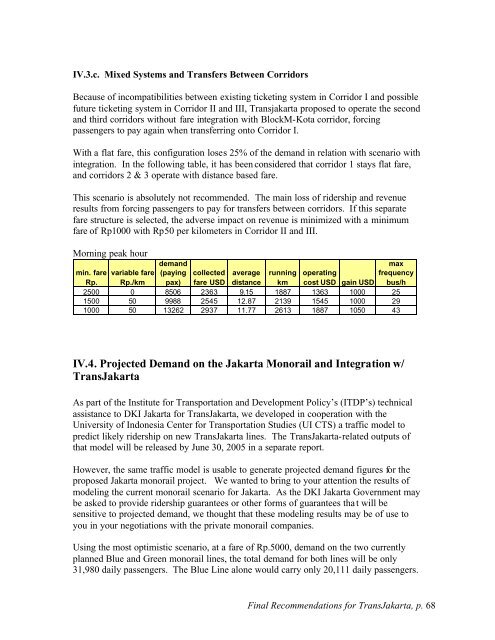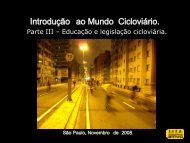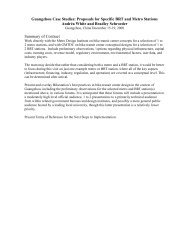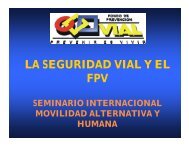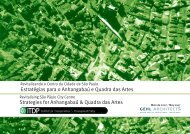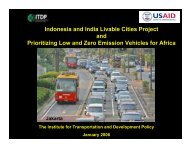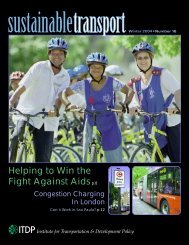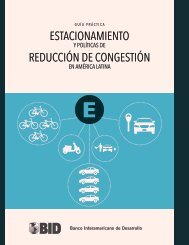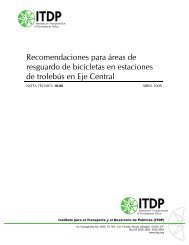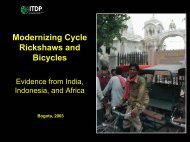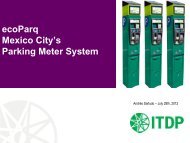Making TransJakarta a World Class BRT System - ITDP | Institute for ...
Making TransJakarta a World Class BRT System - ITDP | Institute for ...
Making TransJakarta a World Class BRT System - ITDP | Institute for ...
You also want an ePaper? Increase the reach of your titles
YUMPU automatically turns print PDFs into web optimized ePapers that Google loves.
IV.3.c. Mixed <strong>System</strong>s and Transfers Between Corridors<br />
Because of incompatibilities between existing ticketing system in Corridor I and possible<br />
future ticketing system in Corridor II and III, Transjakarta proposed to operate the second<br />
and third corridors without fare integration with BlockM-Kota corridor, <strong>for</strong>cing<br />
passengers to pay again when transferring onto Corridor I.<br />
With a flat fare, this configuration loses 25% of the demand in relation with scenario with<br />
integration. In the following table, it has been considered that corridor 1 stays flat fare,<br />
and corridors 2 & 3 operate with distance based fare.<br />
This scenario is absolutely not recommended. The main loss of ridership and revenue<br />
results from <strong>for</strong>cing passengers to pay <strong>for</strong> transfers between corridors. If this separate<br />
fare structure is selected, the adverse impact on revenue is minimized with a minimum<br />
fare of Rp1000 with Rp50 per kilometers in Corridor II and III.<br />
Morning peak hour<br />
demand<br />
(paying<br />
pax)<br />
max<br />
frequency<br />
bus/h<br />
min. fare variable fare collected average running operating<br />
Rp. Rp./km<br />
fare USD distance km cost USD gain USD<br />
2500 0 8506 2363 9.15 1887 1363 1000 25<br />
1500 50 9988 2545 12.87 2139 1545 1000 29<br />
1000 50 13262 2937 11.77 2613 1887 1050 43<br />
IV.4. Projected Demand on the Jakarta Monorail and Integration w/<br />
<strong>TransJakarta</strong><br />
As part of the <strong>Institute</strong> <strong>for</strong> Transportation and Development Policy’s (<strong>ITDP</strong>’s) technical<br />
assistance to DKI Jakarta <strong>for</strong> <strong>TransJakarta</strong>, we developed in cooperation with the<br />
University of Indonesia Center <strong>for</strong> Transportation Studies (UI CTS) a traffic model to<br />
predict likely ridership on new <strong>TransJakarta</strong> lines. The <strong>TransJakarta</strong>-related outputs of<br />
that model will be released by June 30, 2005 in a separate report.<br />
However, the same traffic model is usable to generate projected demand figures <strong>for</strong> the<br />
proposed Jakarta monorail project. We wanted to bring to your attention the results of<br />
modeling the current monorail scenario <strong>for</strong> Jakarta. As the DKI Jakarta Government may<br />
be asked to provide ridership guarantees or other <strong>for</strong>ms of guarantees that will be<br />
sensitive to projected demand, we thought that these modeling results may be of use to<br />
you in your negotiations with the private monorail companies.<br />
Using the most optimistic scenario, at a fare of Rp.5000, demand on the two currently<br />
planned Blue and Green monorail lines, the total demand <strong>for</strong> both lines will be only<br />
31,980 daily passengers. The Blue Line alone would carry only 20,111 daily passengers.<br />
Final Recommendations <strong>for</strong> <strong>TransJakarta</strong>, p. 68


